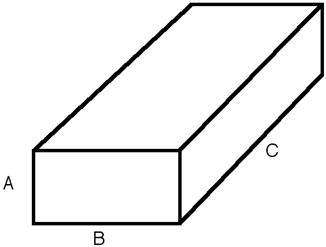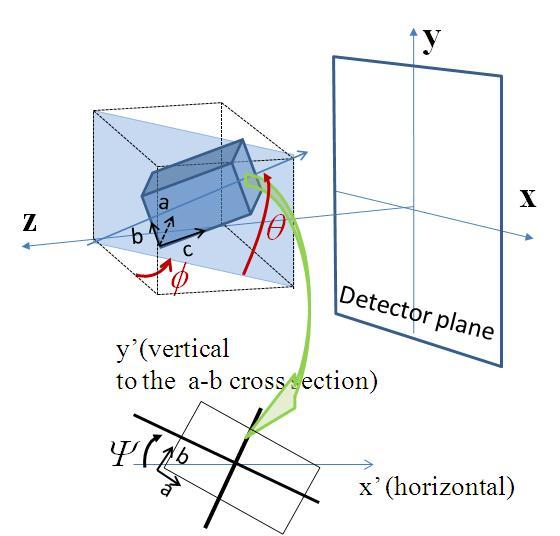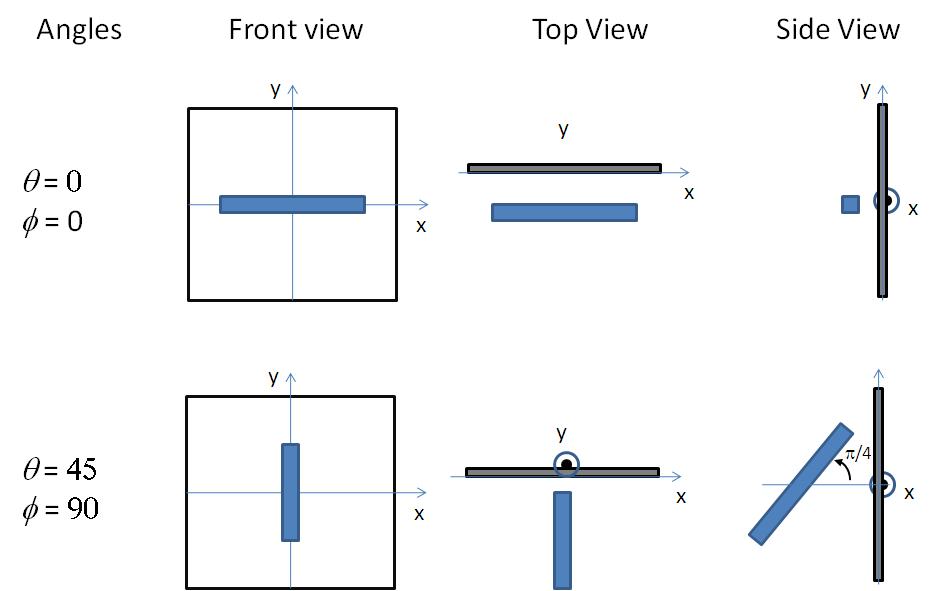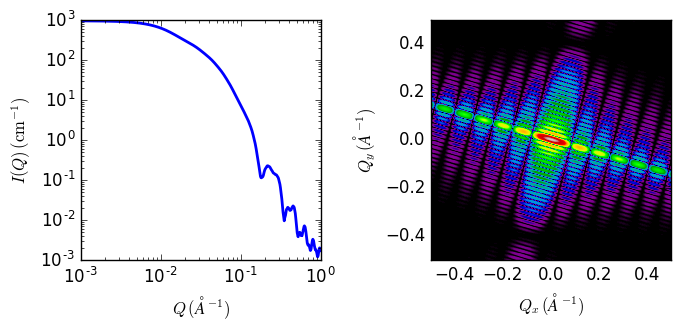parallelepiped
Rectangular parallelepiped with uniform scattering length density.
| Parameter | Description | Units | Default value |
|---|---|---|---|
| scale | Source intensity | None | 1 |
| background | Source background | cm-1 | 0.001 |
| sld | Parallelepiped scattering length density | 10-6Å-2 | 4 |
| sld_solvent | Solvent scattering length density | 10-6Å-2 | 1 |
| length_a | Shorter side of the parallelepiped | Å | 35 |
| length_b | Second side of the parallelepiped | Å | 75 |
| length_c | Larger side of the parallelepiped | Å | 400 |
| theta | In plane angle | degree | 60 |
| phi | Out of plane angle | degree | 60 |
| psi | Rotation angle around its own c axis against q plane | degree | 60 |
The returned value is scaled to units of cm-1 sr-1, absolute scale.
The form factor is normalized by the particle volume. For information about polarised and magnetic scattering, see the Polarisation/Magnetic Scattering documentation.
Definition

Fig. 57 Parallelepiped with the corresponding definition of sides.
Note
The edge of the solid must satisfy the condition that \(A < B < C\). This requirement is not enforced in the model, so it is up to the user to check this during the analysis.
The 1D scattering intensity \(I(q)\) is calculated as:
where the volume \(V = A B C\), the contrast is defined as \(\Delta\rho = \rho_\text{p} - \rho_\text{solvent}\), \(P(q, \alpha)\) is the form factor corresponding to a parallelepiped oriented at an angle \(\alpha\) (angle between the long axis C and \(\vec q\)), and the averaging \(\left<\ldots\right>\) is applied over all orientations.
Assuming \(a = A/B < 1\), \(b = B /B = 1\), and \(c = C/B > 1\), the form factor is given by (Mittelbach and Porod, 1961)
with
The scattering intensity per unit volume is returned in units of cm-1.
NB: The 2nd virial coefficient of the parallelepiped is calculated based on the averaged effective radius \((=\sqrt{A B / \pi})\) and length \((= C)\) values, and used as the effective radius for \(S(q)\) when \(P(q) \cdot S(q)\) is applied.
To provide easy access to the orientation of the parallelepiped, we define three angles \(\theta\), \(\phi\) and \(\Psi\). The definition of \(\theta\) and \(\phi\) is the same as for the cylinder model (see also figures below).
The angle \(\Psi\) is the rotational angle around the \(C\) axis. For \(\theta = 0\) and \(\phi = 0\), \(\Psi = 0\) corresponds to the \(B\) axis oriented parallel to the y-axis of the detector with \(A\) along the z-axis. For other \(\theta\), \(\phi\) values, the parallelepiped has to be first rotated \(\theta\) degrees around \(z\) and \(\phi\) degrees around \(y\), before doing a final rotation of \(\Psi\) degrees around the resulting \(C\) to obtain the final orientation of the parallelepiped. For example, for \(\theta = 0\) and \(\phi = 90\), we have that \(\Psi = 0\) corresponds to \(A\) along \(x\) and \(B\) along \(y\), while for \(\theta = 90\) and \(\phi = 0\), \(\Psi = 0\) corresponds to \(A\) along \(z\) and \(B\) along \(x\).

Fig. 58 Definition of the angles for oriented parallelepipeds.

Fig. 59 Examples of the angles for oriented parallelepipeds against the detector plane.
For a given orientation of the parallelepiped, the 2D form factor is calculated as
with
and the scattering intensity as:
Validation
Validation of the code was done by comparing the output of the 1D calculation to the angular average of the output of a 2D calculation over all possible angles.
This model is based on form factor calculations implemented in a c-library provided by the NIST Center for Neutron Research (Kline, 2006).

Fig. 60 1D and 2D plots corresponding to the default parameters of the model.
References
P Mittelbach and G Porod, Acta Physica Austriaca, 14 (1961) 185-211
R Nayuk and K Huber, Z. Phys. Chem., 226 (2012) 837-854